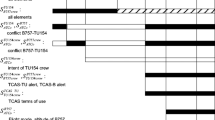Abstract
This paper applies a distributed theory of situation awareness based upon the analysis of interactions between agents (both human and non-human) in an Airborne Warning and Control System (Boeing E3D Sentry). The basic tenet of this approach is that agents within a system each hold their own component(s) of situation awareness, which may be very different from, but compatible with, other agent’s view of the situation. However, it is argued that it is not always necessary to have complete sharing of this awareness, as different system agents have different purposes. Situation awareness is regarded as a dynamic and collaborative process that binds agents together on tasks on a moment-by-moment basis. Situation awareness is conceptualised as residing at a system, not an individual level. Data were collected from crew-members in theE3D during a series of simulated air battles. These data pertained to task structure, communications between the crew and the collection and analysis of crew actions at critical decision points. All phases of operations were considered. From these data propositional networks were developed in which key knowledge objects were identified. Analysis of these networks clearly shows how the location and nature of distributed situation awareness changes across agents with regard to the phase of operation/air battle.





Similar content being viewed by others
References
Annett J (2005) Hierarchical task analysis. In: Stanton NA, Hedge A, Salas E, Hendrick H, Brookhaus K (eds) Handbook of human factors and ergonomics methods. Taylor and Francis, London, pp 33-1–33-7
Annett J, Cunningham DJ, Mathias-Jones P (2000) A method for measuring team skills. Ergonomics 43:1076–1094
Anderson JR (1980) Cognitive psychology and its implications. Freeman, San Francisco
Artman H (2000) Team situation assessment and information distribution. Ergonomics 43(8):1111–1128
Artman H, Garbis C (1998) Situation awareness as distributed cognition. In: Green TRG (ed) Proceedings of European Conference on Cognitive Ergonomics. Limerick, Ireland, pp 151–156
Ashleigh MJ, Stanton NA (2001) Trust: key elements in human supervisory control domains. Cogn Technol Work 3:92–100
Bell HH, Lyon DR (2000) Using observer ratings to assess situation awareness In: Endsley MR (ed) Situation awareness analysis and measurement. LEA, Mahwah, pp 129–146
Collins AM, Loftus EF (1975) A spreading-activation theory of semantic processing. Psychol Rev 82:407–428
Flor NV, Hutchins EL (1991) Analyzing distributed cognition in software teams: a case study of team programming during perfective software maintenance. In: Koenemann-Belliveau J, Moher TG, Robertson SP (eds) empirical studies of programmers: fourth workshop. Ablex, Norwood pp 36–64
Gibson H, Walker GH, Stanton NA, Baber C (2005) EAST (Event Analysis of Systemic Teamwork): A novel integration of ergonomics methods to analyse C4i activity. Ergonomics (submitted)
Hancock PA (1997) Essays on the future of human–machine systems. Banta Press, Minneapolis
Hollnagel E (1993) Human reliability analysis—context and control. Academic, London
Houghton RJ, Baber C, Cowton M, Stanton NA (2006a) WESTT (Workload, Error, Situational Awareness, Time and Teamwork): An analytical prototyping system for command and control. Cogn Technol Work (this issue)
Houghton RJ, Baber C, McMaster R, Stanton NA, Salmon P, Stewart R, Walker G (2006b) Command and control in emergency services operations: a social network analysis. Ergonomics 49:1204–1225
Hutchins E (1991) The technology of team navigation. In: Galegher J, Kraut RE, Egido C (eds) Intellectual tamwork. LEA, Hillsdale, pp 191–220
Hutchins E (1995) How a cockpit remembers its speeds. Cogn Sci 19(3):265–288
Klein GA (1989) Recognition-primed decisions. In: Rouse WB (ed) Advances in man–machine systems research, vol 5, Jai, Greenwich, pp 47–92
Klein G, Armstrong AA (2005) Critical decision method. In: Stanton NA, Hedge A, Salas E, Hendrick H, Brookhaus K (eds) Handbook of human factors and ergonomics methods. Taylor and Francis, London, pp 35-1–33-8
Norman D (1988) The psychology of everyday things. Basic Books, New York
Ogden GC (1987) Concept, knowledge and thought. Annu Rev Psychol 38:203–227
Perry M (2003) Distributed cognition. In: Carroll JM (ed) HCI models, theories and frameworks. Morgan-Kaufman, San Francisco, pp 93–224
Quillian R (1969) The teachable language comprehender: a simulation program and theory of language. Commun ACM, 12459–476
Smith K, Hancock PA (1995) Situation awareness is adaptive, externally directed consciousness. Human Factors 37:137–148
Stanton NA, Connelly V, Prichard J, van Vugt M (2002) Assessing the effects of location, media and task type on team performance. J Def Stud 7(1):29–41
Stanton NA, Baber C, Walker GH, Salmon P, Green D (2004) Toward a theory of agent-based systemic situational awareness. In: Vincenzi DA, Mouloua M, Hancock PA (eds) Proceedings of the Second Human Performance, Situation Awareness and Automation Conference (HPSAAII), Daytona Beach, FL, pp 22–25
Stanton NA, Ashleigh MJ, Roberts AD, Xu F (2006a) Levels of abstraction in human supervisory control teams. J Enterp Inf Manage 19(6):676–694
Stanton NA, Stewart R, Harris D, Houghton RJ, Baber C, McMaster R, Salmon P, Hoyle G, Walker G, Young MS, Linsell M, Dymott R, Green D (2006b) Distributed situation awareness in dynamic systems: theoretical development and application of an ergonomics methodology. Ergonomics 49(12–13):1288–1311
Stewart RJ, Salmon P, Kay A (2004) E3D Operations. DTC Report. WP1.1.2
Author information
Authors and Affiliations
Corresponding author
Rights and permissions
About this article
Cite this article
Stewart, R., Stanton, N.A., Harris, D. et al. Distributed situation awareness in an Airborne Warning and Control System: application of novel ergonomics methodology. Cogn Tech Work 10, 221–229 (2008). https://doi.org/10.1007/s10111-007-0094-8
Received:
Accepted:
Published:
Issue Date:
DOI: https://doi.org/10.1007/s10111-007-0094-8




